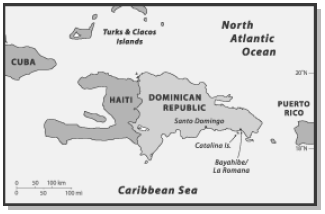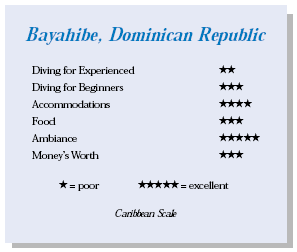Bayahibe, Dominican RepublicContents of this Issue: What if the Burst Disk Doesn’t Burst? Ocean Rover, Andaman Sea, Thailand Luxfer Tank Trade-In Is No Bargain, But Worthwhile Is Your Live-Aboard Safe? – Part II Editorial Office: Ben Davison Publisher and Editor Undercurrent 3020 Bridgeway, Suite 102 Sausalito, CA 94965 not bad for an all-inclusive romantic getaway from the June, 2003 issue of Undercurrent
Dear Fellow Diver: Had you been a reader of Skin Diver before it bellied up, you would have surely been tempted to dive the Dominican Republic, which, with its adjacent neighbor Haiti, sits between Cuba and Puerto Rico. After all, the Dominican Republic spent a lot of ad money there and in return received glowing reviews. Undercurrent readers have reported little good about the diving. A common destination, which I once dived, is Punta Cana, with a small patch of sickly reef trashed with Presidente beer containers and Styrofoam cups. The operators tell you straight out that it's disappointing scuba and offer to bus you up to 90 minutes for better diving. Still, my nondiving partner was allured by the Dominican Republic's modestly priced, all-inclusive hotels on sparkling beaches, and I reluctantly agreed -- as long as I could find a serious dive operator with a fair-to-middlin' chance of decent diving. I picked Bayahibe/LaRomana area and the Iberostar Hacienda Dominicus. The resort is a 20-minute cab ride from the Casa de Campo/La Romana airport, two hours from Santo Domingo. Less than two years old, the immaculately maintained Iberostar is constructed of local materials and similarly styled. Its high ceilings, wide and open-sided corridors, expansive landscaping (ponds, gardens, and topiary), and separate buildings make it more intimate than its nearly 500 rooms suggest. Despite being nearly full during my March stay, there was no waiting at restaurants, bars, or the front desk. Most of the hotel's customers were European, including many Germans and Italians, with a smaller number from the U.S., U.K. and Canada. Despite this, English is widely spoken by resort and dive staff. The on-site shop, Dressel Divers, offered one morning and one afternoon dive at $49 per. For remote sites, like Catalina, the tab for two dives, lunch included, ran an exorbitant $149. Nearby local shops -- Scubafun and Casa Daniel -- run two morning dives at $20-25 each, with only a $30 add-on for remote excursions and lunch. I dove with Scubafun, owned by a pleasant and efficient German woman, Martina, her mate, Werner, and a hoot of an Englishman named Tom. Fronting on the unpaved, pot-holed main street of tiny, funky Bayahibe, the shop's rentals include Apeks regulators and other gear, and a DPV for $19. They are installing Nitrox. Air fills were an honest 3,000 psi. Scubafun has several boats, all in good repair. Each has tank racks for six to eight divers and carries a cell phone and first aid kit, but oxygen is back at the shop. If you want anything to eat or drink, stop at the colmado (market) next door and stock up. Hotel pick-ups, and dive departures and returns, are predictably on Caribbean time. Dive briefings were fine. My dives began with an easy back roll, but the exits were a pain even after handing up my gear. While much of the area around Bayahibe is a national park, it is fished to a farethee- well. Local authorities once had a nice boat and motor for patrolling, but they were somehow "sold." Nonetheless, I got off on the right scuba foot on the largely fishless St. George Wreck, a 240-foot steel freighter sunk three years ago. It sits upright on a sand bottom, the superstructure at 45 feet. I dropped down to 150 feet to appreciate the craft from below. While I penetrated several holds and the bridge, she appeared clear of entanglements and silt. It was just myself, one advanced student, and divemaster Martin, so I did my own thing with the usual caveat -- be back under the boat with 500 psi. Never was I mother-henned, which added immensely to my enjoyment. With little to no current, and the water at 82 degrees, I was happy despite no encrustation on the boat or any fish bigger than small trumpetfish. The lack of marine life, however, gave a strange poignancy to a solitary West Indian sea egg foraging its way along the stack. We moved to Guaraguao, a simple patch reef interspersed with sand breaks at 60 feet but in better health than some I've seen elsewhere in the Caribbean. The site was spattered with typical reef fish including brown chromis, tomtates, and smallmouth grunts. Schools of juvenile creole wrasse were less frenetic than the adults. Hamlets, including the unusual golden species, were well represented. In the sand I spotted garden eels, yellowfin mojarra, and yellow and spotted goatfish. Trumpetfish, blackbar soldierfish, spotted drum, and highhats were in profusion here and on most reef dives. Two dives in the Parque Nacional del Este -- the Coca Wreck and Papaya -- were the kind that give DR diving a bad name. The former is a crummy looking, dilapidated fishing boat at 55 feet, while the latter is an anemic patch reef. Neither had much fish life, though I enjoyed following a small goldentail moray as he fearlessly hunted in broad daylight. A personable group from a Brooklyn, N.Y., dive shop was aboard for many dives, and two of their divers were diving doubles provided by Scubafun. Yes, doubles. For a dive plan of 55 minutes at 60 feet. Even so, they pretty much used all their air. Who were these guys? When it seemed that there weren't sufficient tanks for doubles on the second dive -- 50 minutes at 50 feet -- they were gripped by a pathological fear of running out of air. Despite this nonsense, the DMs maintained their poise. Another member of the group, diving an oversized steel tank, zipped by with his dive knife extended and drove it onto a small coral head. Perhaps this idiot was taking revenge for a nasty coral scrape he sported. Death to the killer coral head! The following day things were better. About a 50-minute boat ride, small
Catalitina and Saona Islands hold some fun. On the way out, divemaster Tim gave an informative talk about the Taino Indian sacrificial practices performed at nearby
Peñon. Manatees used to live here, though they've been gone about as long as Taino
virgins. Because of rough water with reduced visibility at the second site, Tim described an alternate dive at nearby Peñon. It is one of the better Caribbean patch reef dives I've done. As well as having colorful corals and sponges, it is loaded with schools of creole wrasse, blackbar soldier fish, and grunts. A school of 60 southern sennet hung in the water column like a slightly disheveled fusillade of silver arrows. Also, at a porcupinefish nursery, four small creatures ventured from their coral head to observe me with E.T.-like faces. I wanted to reach out and tweak their ample cheeks. Having dived with five of Scubafun's divemasters, all of whom were exceedingly laid back and pleasant, a couple of consistent peculiarities emerged. Three had either an octopus or pressure gauge, or both, hanging free and smacking into coral. Only two made any attempt to point out marine life. I did go into Bayahibe to party one evening, starting at the colmado where scuba shop staff and divers often meet to get rolling with a large, cold, flavorful Presidente beer ($1.50). We then shuffled over to L'Incontro, a gravelfloored, open-air spot run by an Italian ex-pat. Toothsome thin-crust, wood oven pizza and two large beers ran $10. Perfect for a nightcap is the Barco Bar, where one can drink in a tree house overlooking the water. On Fridays around midnight, Big Sur gets into some serious jamming, while the pool hall across the way keeps to a more sedate hum. Scubafun saved the best diving for last -- Catalina Island. After a long, wet, and bone-jarring ride, I was rewarded with La Romana's only true wall, cleverly named "The Wall." Starting at 25 feet and bottoming at 140 feet, it's a stunner by Caribbean standards. Dropping through a school of halfbeaks just under the surface, I descended to the wall top, carpeted with profuse stands of yellow pencil, lacy fire, finger, pillar, cactus, and encrusting corals and branching and tube sponges. Deeper, the wall is festooned with large sheet and plate corals, magnificent large sulfur yellow and purple tube sponges and orange elephant ear sponges. Deep-water sea fans and feathery sea plumes rose seven feet off their purchase. On a smaller scale, this wall is reminiscent of San Salvador in the Bahamas. While lacking San Sal's abyssal depths, massiveness of coral, and a chance to spot a hammerhead, "The Wall" was free of the filamentous green algae and heavy dustings of sand that plague San Salvador. There aren't many fish, but I was cheered by a school of 100-plus blue tang hunting the reef top and a row of trumpetfish capitalizing on leftovers. I noted the near absence of many usual Caribbean commoners, such as queen, gray, and French angels and the larger filefishes. I saw only a couple the entire week. And not one grouper. Oddly, I saw large black margate, a green moray of awesome girth that pushed the reported size limits for this creature, and a Cubera snapper easily four feet and more than 100 pounds. It was, as they say in Spanish, a grandote. Interestingly, my final dive, "The Aquarium," a patch reef with a max depth of about 40 feet, was quite fishy, including a school of ten adult highhats and an unusual webbed burrfish. A barrel sponge was wrapped with brittle stars reaching for passing morsels. Back at the hotel, my room had a step-in shower/tub combo, a couch, and king bed. With a phone, fan, non-adjustable A/C, cable TV/remote, stocked minifridge, writing table, and a balcony with outdoor furniture, I was comfortable indeed. Corner rooms on the top floor had double windows and a balcony (no elevator), and a junior suite had an ocean view. The staff here was like the late Mr. Rodgers on Prozac. Sporting natty uniforms, their attitudes out-shined the mirrorlike tile floors and beautiful wooden furniture in the common areas. Smiling, helpful, and embarrassingly multilingual, they were genuinely interested in our having a good time. Food was standard all-inclusive fare, ranging from mediocre to good. The buffet served a variety of foods at each meal, including at least one made-to-order station. Plenty of freshly baked bread goods, fruit, and fresh juices at breakfast. There are four specialty restaurants (make reservations when you arrive). The Japanese eatery, themed a la Benihana, was our favorite, followed by the French place. The Mexican restaurant was slow of service, and the "steakhouse," serving modest quality red meat, was simply a conversion of the daytime poolside buffet. Though an all-inclusive resort, they had no irritating surcharges for any entrees at specialty restaurants, no drinks served in dental office-sized cups, and no limitations on domestic-only beers and spirits. Unless you are a traveler looking to learn about a new country, there's little reason to leave the resort (other than to dive). I did visit La Romana, about 20 minutes to the east. A charmless city of about 200,000, it is composed largely of block and cement businesses and houses, while those on the outskirts are in ramshackle wood abodes with thatched or corrugated metal roofs. A sugar cane refinery belched out masses of filthy smoke that hung over the place like a shroud. Stopping to gas up at 1 a.m., children begging money besieged us, but a man carrying a shotgun eventually ran them off. It's obvious why all-inclusives have proliferated in this region. And that suggests what kind of divers might want to visit here -- those who like a first rate all-inclusive, some occasionally decent though not thrilling diving, and perhaps just a romantic getaway at a good price. If those are your expectations, you'll do just fine here. - Doc Vikingo
|

I want to get all the stories! Tell me how I can become an Undercurrent Online Member and get online access to all the articles of Undercurrent as well as thousands of first hand reports on dive operations world-wide
| Home | Online Members Area | My Account |
Login
|
Join
|
| Travel Index |
Dive Resort & Liveaboard Reviews
|
Featured Reports
|
Recent
Issues
|
Back Issues
|
|
Dive Gear
Index
|
Health/Safety Index
|
Environment & Misc.
Index
|
Seasonal Planner
|
Blogs
|
Free Articles
|
Book Picks
|
News
|
|
Special Offers
|
RSS
|
FAQ
|
About Us
|
Contact Us
|
Links
|
3020 Bridgeway, Ste 102, Sausalito, Ca 94965
All rights reserved.

 The larger
of the two boats has a small
stern ladder so close to the propeller
it's a hazard in rough
water even when it's not spinning.
With the smaller boat, I had to
fin myself up over the side, usually
without assistance. When I
finished the dives, I left my
gear at the shop. Next morning
it was rinsed and ready.
The larger
of the two boats has a small
stern ladder so close to the propeller
it's a hazard in rough
water even when it's not spinning.
With the smaller boat, I had to
fin myself up over the side, usually
without assistance. When I
finished the dives, I left my
gear at the shop. Next morning
it was rinsed and ready. Farther on, we cruised the mangrove coves and watched frigate birds,
black pelicans, egrets, and kingfishers going about their daily existence. Snugging behind Catalitina Island, we kitted up
before heading around to Shark Point.
A reef running from 25 to 80 feet
meanders for some distance, with overhangs
that seemed like prime locations
to see the nurse sharks reputed to be
there. Of course, I saw none. What
this site does have in spades are sea
fans, sea rods, and sea whips, and
their relentless to-and-fro movement in
the surge made me wonder if taking
Bonine might not have been a good
idea. This cover was a good place for
trumpetfish and slender filefish. A
two-hour surface interval on lovely
Saona Island allowed for a lunch of
tepid empanadas, assorted fruit and rum
cake, and a refreshing nap.
Farther on, we cruised the mangrove coves and watched frigate birds,
black pelicans, egrets, and kingfishers going about their daily existence. Snugging behind Catalitina Island, we kitted up
before heading around to Shark Point.
A reef running from 25 to 80 feet
meanders for some distance, with overhangs
that seemed like prime locations
to see the nurse sharks reputed to be
there. Of course, I saw none. What
this site does have in spades are sea
fans, sea rods, and sea whips, and
their relentless to-and-fro movement in
the surge made me wonder if taking
Bonine might not have been a good
idea. This cover was a good place for
trumpetfish and slender filefish. A
two-hour surface interval on lovely
Saona Island allowed for a lunch of
tepid empanadas, assorted fruit and rum
cake, and a refreshing nap. Diver's Compass: For the Iberostar Hacienda Dominicus (
Diver's Compass: For the Iberostar Hacienda Dominicus (